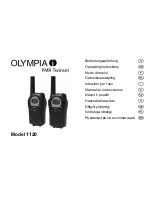
2-1
RF-7800W
SYSTEM INSTALLATION
R
CHAPTER 2
SYSTEM INSTALLATION
2.1
INTRODUCTION
Consider the following before installing a RF-7800W High Capacity Line of Sight (HCLOS) Radio system:
•
Environmental and Line of Sight concerns
•
Link Availability
•
System Configuration
•
Co-location
2.1.1
Environmental and Line of Sight Concerns
The RF-7800W is a microwave radio, which demands better Line of Sight (LOS) conditions than other radios that
operate with a lower frequency. Optical Line of Sight (OLOS) alone may not be adequate enough to maintain a
healthy link between radios. The radio operates at a lower power than other Harris radios, but high-gain antennas
give it the ability to link over many tens of kilometers in some situations. At these distances, weather and the
curvature of the Earth can become major factors affecting link quality. A thorough propagation study and analysis
using industry standard ITU recommended guidelines should be performed before deploying radios in an unknown
or unfamiliar location.
2.1.2
Link Availability
Harris provides a free tool to users that wish to perform a simple evaluation of a single RF-7800W radio link under
ideal environmental and terrain conditions. The Link Budget Tool (available via the Harris Premier site
https://rfcommpremier.harris.com
) provides a rudimentary calculation of annual Link Availability (Uptime) and can
help users choose the right antenna for their specific installation.
2.1.3
System Configuration
There are two configuration types:
•
Simple Point to Point (SPTP) - Two RF-7800W radios are used, one as a Sector Controller (SC) and one as
a Subscriber Station (SS).
•
Simple Point to Multipoint (SPMP) - Two or more RF-7800W radios are used, one as a Sector Controller
(SC) and the rest as Subscriber Stations (SS).
Some RF-7800W link configuration and statistics are split into downlink and uplink. The downlink direction always
refers to data or signals transmitted by the SC down to the SS. The uplink direction always refers to data or signals
transmitted by the SS up to the SC.
2.1.4
Co-location
Radio co-location on a single mast or tower system is sometimes unavoidable. A number of strategies can be
employed to reduce the possibility of interference between radios. Higher gain antennas typically have a narrower
beamwidth, which can help increase the signal to noise ratio (SNR) if they are not pointed in the same direction. If
possible, co-located radios should use operating frequencies that are at least one full channel width away from each
other.
Summary of Contents for RF-7800W-OU49 series
Page 3: ......
Page 5: ......
Page 15: ...x RF 7800W SAFETY SUMMARY R This page intentionally left blank...
Page 38: ...3 7 RF 7800W SYSTEM ADMINISTRATION AND CONFIGURATION R Figure 3 4 System Configuration...
Page 64: ...3 33 RF 7800W SYSTEM ADMINISTRATION AND CONFIGURATION R Figure 3 18 File Management...
Page 67: ...3 36 RF 7800W SYSTEM ADMINISTRATION AND CONFIGURATION R This page intentionally left blank...
Page 73: ...4 6 RF 7800W TROUBLESHOOTING AND MAINTENANCE R This page intentionally left blank...
Page 83: ...A 6 RF 7800W APPENDIX A R This page intentionally left blank...
















































